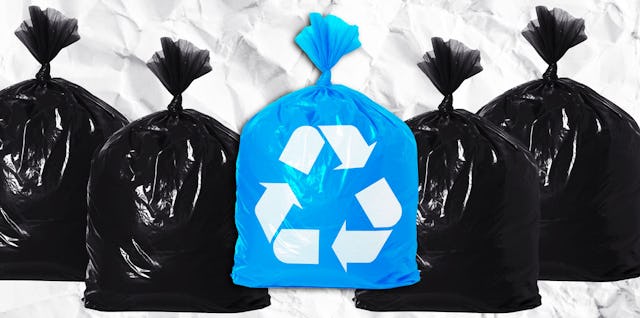Beware Of Wish-Cycling When You Go Marie Kondo On Your Stuff

Winter is slow to release its grip in the northern parts of the northeast, and spring is just a slightly warmer winter mixed with mud and pollen until late May where I live in Vermont. So when we finally open the windows to let in all of the fresh air, everything is quickly coated with layers of yellow dust. This is a signal to start the gratifying work of spring cleaning, which prompts projects that declutter, which leads to purging. It’s almost like I become the main character in a version of the book “If You Give A Mouse A Cookie. If you give me a rag, I will take 18 boxes of stuff to Goodwill. But guilt over getting rid of something that may seem functional but no longer useful to me means I’m likely donating trash that really just needs to go to the dump. I am guilty of wish-cycling, and you may be too.
Wish-cycling is a problematic practice of people recycling something that isn’t actually recyclable. The thing is trash, but people are hoping it can be reused or turned into something new. Now that I think of it, this phrase can probably be used on people too. I digress. This thing you don’t want to put in the landfill could be a pizza box or a table with a wobbly leg you think someone will want to buy and fix up.
The grease on the cardboard makes it trash because it will contaminate a whole batch of material or damage processing equipment. Other non-recyclables that I have been guilty of trying to recycle have been plastic lids, household glass (or broken glass!), shredded paper, and certain yogurt cups. Not all plastics are the same and some items are too small or too unknown to put through an expensive processing machine. Get a list of what you can recycle from your trash removal service or the local dump.
I think I do this because as an ’80s and ’90s kid I grew up on reuse-reuse-recycle and it kills me to throw something in the trash. But willing something into a second life is negating some of my environmental drive to make the planet a cleaner place. I tend to have decent judgement when it comes to getting rid of household items I no longer want, but not everyone can let go of the idea that the finicky microwave or a wobbly table could be someone else’s treasure. Someone who can’t afford or who doesn’t want to buy new shouldn’t have to settle for fussy appliances and your wonky shit.
Михаил Руденко/Getty
Goodwill likely can’t sell these things either. Instead they end up spending millions of dollars and too many hours sorting through our good intentions to just place them in the landfill we so desperately wanted to avoid. Last year alone, Goodwill threw away 13 million pounds of waste in its 30 store locations in Vermont, New Hampshire, and Maine. They try to recycle and reuse what they can’t sell and refurbish broken electronics but mostly they do what most of us are hesitant to do: trash it.
Heather Steeves, a spokesperson for the 30 Goodwill locations in Vermont, New Hampshire, and Maine says, “We hope everyone brings great things that help our programs, but we know some people make some questionable judgments about what is good to donate.” Before dropping off your donation at Goodwill, she suggests asking yourself, would you want to spend money on this product if you needed it?
People donate what turns out to be trash because of laziness, cheapness, or financial barriers that prohibit proper disposal of something that doesn’t fit in the home trash can. It costs money to take many items to a town dump, so leaving it on the side of the road or at the doors of a donation center is easy and sometimes the only affordable option. But for those of us who do have the means to pay for what we no longer want or need, we should be a lot more honest about where it should go.
Sometimes it’s just better to trash something. Recycling—either at home, at the dump, or a second-hand store—is only beneficial if it can actually be turned into something new or reused. This means we need to find a way to be okay with recycling less; we should focus on the fact that by being more careful about what we think is reusable is causing less harm to recycling facilities and businesses that are built on selling second-hand products.
And if you don’t want to add to the landfill, then make everyday changes to produce less waste. Use reusable shopping bags, buy in bulk, ditch the single-use plastic coffee pods, and be sure what you buy is 100% recyclable. As far as those appliances on the fritz, support a local business or handy person and get them fixed. Or pretend you’re on a DIY show and throw a new coat of stain on a dresser or recover some cushions on a chair before tossing them aside.
We can’t always expect our waste to be reborn, but we can make better buying decisions and discard the stuff that no longer serves us in smarter ways.
This article was originally published on